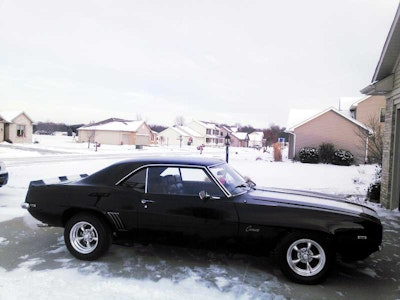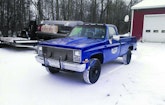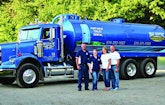Interested in Portable Sanitation?
Get Portable Sanitation articles, news and videos right in your inbox! Sign up now.
Portable Sanitation + Get AlertsWhen the septic work slows during northern Indiana winters, pumper Jim Garris, 46, and business partner Kenton Brubacher, 37, can be found with paint sprayer in hand, sprucing up vehicles and farm equipment with a glossy new finish. They have a 50- by 20-foot spray booth inside the 120- by 80-foot shop, where they also do welding and repairs.
From November through March, Garris and Brubacher take on six to nine painting jobs, anything from motorcycles to trucks and trailers. This past winter, the co-owners of J & K Septic Pumping and Repair Service in New Paris, Indiana, rebuilt a pair of 3/4-ton Chevy pickups they use for snowplowing. They also put the finishing touches on their vacuum truck – a 1997 Freightliner with 4,700-gallon steel tank (4,400 waste/300 freshwater) built in their shop.
A change to relax
“It’s my passion,” Garris says. “It’s what I like to do when I’m not working my regular job, which is installing septic systems and pumping.”
Brubacher agrees.
“It’s a change of pace,” he says. “It relieves your mind of other stresses.”
The business partners met while working for the same excavating company in the 1990s. When work slowed down, they went their separate ways. Brubacher took a job with a well driller and ran a business installing waterlines, while Garris went to work for another excavating company before going into business for himself in 2004.
“My job was primarily installing septic systems,” he says. “When you’re doing repairs, you’re always waiting on pump trucks, so in the back of my mind I thought that would be a good business to get into.”
When the recession hit in 2008, the friends and former co-workers decided to partner up once again.
Their first truck was a 1985 International with an 1,800-gallon vacuum tank and 125-gallon plastic water tank. In 2009 they added 10 portable restrooms. Today, they have 105 Tuff-Jon units from the T.S.F. Company, two ADA units from Armal and two from PolyJohn Enterprises, along with 10 dual-sink wash stations from T.S.F.
Plowing ahead
During the winter months, Garris and Brubacher also plow snow when not busy in the paint booth.
“We plow for our local county,” Garris says. “We have 25 miles of road that we do. We also have about eight commercial accounts.”
Their inventory of snowplows includes a 2005 Ford F-250 with 9 1/2-foot BOSS blade and 2002 Dodge dually with a 10-foot blade, as well as a Cat skid-loader and Mustang skid-loader – both with 10-foot BOSS plows.
Painting, however, is their true winter passion.
“We’ve done some farm tractors, and we’re doing my business partner’s motorcycle – he’s got a Harley-Davidson,” Garris says. “Last winter we did my Harley-Davidson.” Brubacher’s 1991 Ultra Classic wears J & K Septic’s trademark blue and silver colors – the same as Garris’ customized 1991 Heritage Softail.
Garris’ other pride and joy is his 1969 Chevy Camaro coupe – black with white stripes – powered by a 350-cubic-inch engine. Garris and his wife, Kristi, enjoy taking their classic car to cruise-ins during the summer months. Still on his bucket list is a 1965 Chevy II Nova.
“I just like that style of car,” Garris says. “It’s small yet has a V8 engine, so it’s a lot of power on a small frame.”
Starting young
Garris has been doing paint and body work since age 15. Growing up in New Paris, a farming community of about 1,500, he lived around the corner from a body shop. The owner taught Garris the trade and let him work evenings throughout high school to perfect his skills. Garris charges about $2,800 to paint a typical pickup. His most time-intensive project was the company’s blue and silver pump truck, which took three months to complete.
“We rewired everything and sandblasted the whole truck,” he says. “We put new rims and tires on; put some diamond plate in the hose trays and toolboxes.”
Their clientele comes mostly through word-of-mouth.
“We don’t advertise too much, but we stay pretty busy at it,” Garris says. “It’s one of those things we enjoy doing. It’s something different from the summer routine.”
A job well done
Garris says the key to a good paint job is patience.
“It’s something you can’t rush,” he says. “You have to take your time with it. You have to wait 15-20 minutes between coats, especially when you’re applying the clear coat.”
Garris begins by giving each vehicle a thorough washing before removing the lights, mirrors and door panels. “We pretty much disassemble it,” he says. “Then we sandblast, patch and do any bodywork that needs to be done.”
Next comes the primer, followed by three coats of the base color and three to four layers of clear coat. The final step is putting everything back together.
Brubacher learned the body trade from his father and by working on his own 1978 four-wheel-drive, 3/4-ton Chevy pickup. “That was about 15 years ago,” he says. “We replaced the rocker panels, the cab corners and the doors, and primed and painted it.”
Brubacher painted his first truck Patriot blue, although Bayside blue metallic was the color of choice for the Harley he takes on enjoyable summer runs.
“That’s my only vacation,” he says. “I’ll go for a week. We’ve been to Tennessee several times on the Dragon’s Tail.”
The Dragon’s Tail is an 11-mile stretch of U.S. 129 that crosses the Tennessee/North Carolina state line. With 318 curves, it is considered to be one of the foremost motorcycling and sports car roads in the world.
Last year he went to Wisconsin and this year to Gatlinburg, Tennessee. Brubacher’s wife, Tavia, rides along, and the couple is joined by several other bikes.
Still on Brubacher’s bucket list is a five-window 1948 Chevy pickup – to be painted blue, of course.
“I think it would be kind of neat to have an old pickup to run around with,” he says. “I just like the body style, and there aren’t many around.”
So you’re planning to paint your vacuum truck?
Go dark: Consider blue, green or red over white for your vacuum truck, says Jim Garris, co-owner of J & K Septic Pumping and Repair Service in New Paris, Indiana. “Light colors show the dirt so much more.”
Rule out rust: Check joints where hose trays meet for signs of corrosion and underneath where moisture can become trapped. Those are often the main trouble spots. Clean up and touch up areas that show signs of rust.
Coat it: Bedcoat your hose trays. Not only does a quality bedliner protect your truck against stones and road debris, it helps prevent road salt from settling in trouble spots.
Not on aluminum: Painting your aluminum tank might seem a good idea, but it’s often wasted effort, Garris contends. “Over a few years it starts peeling off, even if you prep it correctly.”
Keep it clean: Washing and waxing your truck is the best way to preserve its finish. A word of caution: Wait at least 30 days before applying wax to new paint. Garris waxes his vacuum trucks each spring and fall and washes them about three times a week using a wash/wax formula.









